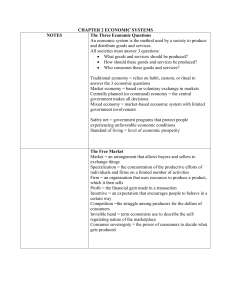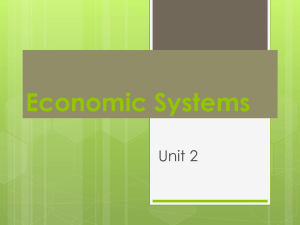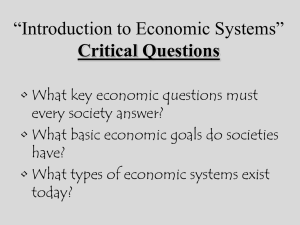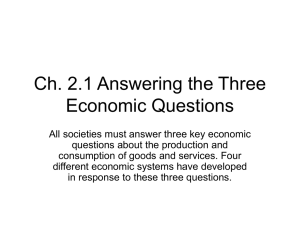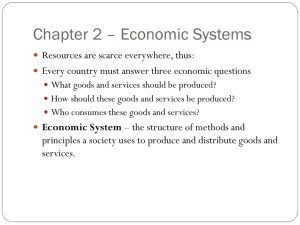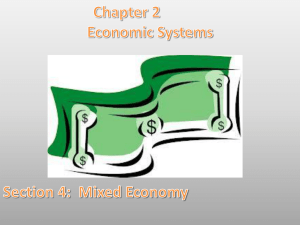powerpoint unit 2 wiki
advertisement
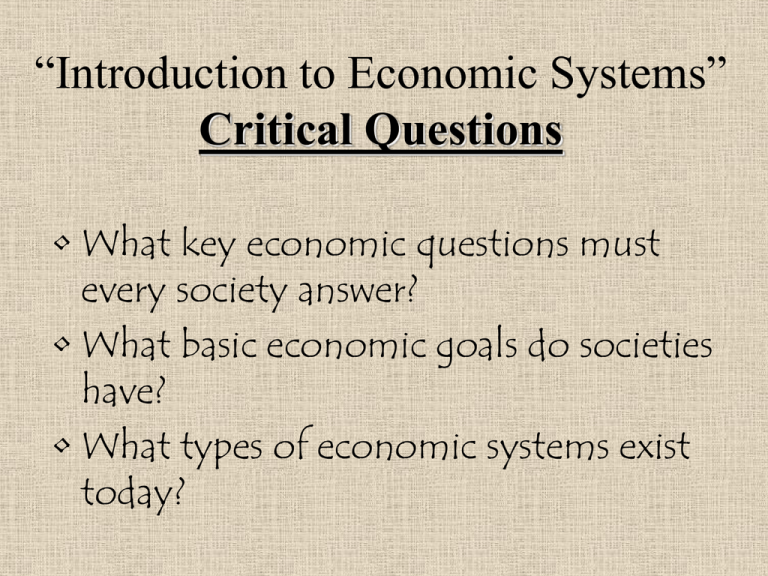
“Introduction to Economic Systems” Critical Questions • What key economic questions must every society answer? • What basic economic goals do societies have? • What types of economic systems exist today? What is an economic system? The method used by a society to produce and distribute goods and services The Three Questions that Determine a Societies Economic System Because ALL economic resources are scarce, every society must answer three questions: – What goods and services should be produced? • Guns or butter? – How should these goods and services be produced? • What combination of factor resources should we use? – Who consumes these goods and services? • How will income be distributed? Economic Goals Societies answer the three economic questions based on their goals and values. Economic Goals Economic Goals Economic efficiency Making the most of resources Economic freedom Freedom from government intervention in the production and distribution of goods and services Economic security and predictability Assurance a safety net will protect individuals in times of economic disaster Economic equity Fair distribution of wealth Economic growth and innovation Other goals Innovation leads to economic growth, and economic growth leads to a higher standard of living. Environmental protection, variety Four Economic Systems An economic system is the method used by a society to produce and distribute goods and services. Traditional economies rely on habit, custom, or ritual to decide what to produce, how to produce it, and to whom to distribute it. In a centrally planned economy the central government makes all decisions about the production and consumption of goods and services. In a market economy economic decisions are made by individuals and are based on exchange, or trade. Mixed economies are systems that combine the free market with limited government intervention. Comparing Economic Systems Economic System Who answers the 3 ?’s • • • • • • • • Traditional Market Centrally Planned Mixed Custom Individuals Central Government Individuals with some government involvement Traditional System • Agricultural and hunting societies. • There is little room for innovation or change. • They tend to lack modern conveniences and have a low standard of living. • Close knit communities with focus on the family unit. The Free Market System (a.k.a. Capitalism) Why do markets exist? Markets exist because none of us produces all the goods and services we require to satisfy our needs and wants. A market is an arrangement that allows buyers and sellers to exchange goods and services. Specialization is the concentration of the productive efforts of individuals and firms on a limited number of activities. Free Markets Circular Flow Diagram of a Market Economy • In a free market economy, households and business firms use markets to exchange money and products. Households • Households own the factors of production and consume goods and services. monetary flow physical flow Firms physical flow monetary flow Adam Smith (1723-90) • Scottish social philosopher and professor • “An Inquiry into the Nature and Causes of the Wealth of Nations” (1776) – 10 years to write – 5 volumes • “Laissez faire” • The Invisible Hand – Self Interest (Motivating Force) – Competition (Regulating Force) Advantages of the Economic Efficiency Free Market As a self-regulating system, a free market economy is efficient. Economic Growth Because competition encourages innovation, free markets encourage growth. Economic Freedom Free market economies have the highest degree of economic freedom of any economic system. Additional Goals, i.e. variety Free markets offer a wider variety of goods and services than any other economic system. Centrally Planned Economies The government,or central authority controls the economy. Organization of Centrally Planned Economies In a centrally planned economy, the government owns both land and capital. The government decides what to produce, how much to produce, and how much to charge. Socialism is a social and political philosophy based on the belief that democratic means should be used to distribute wealth evenly throughout a society. Communism is a political system characterized by a centrally planned economy with all economic and political power resting in the hands of the government. Communist governments are authoritarian in nature. • German philosopher • Radical approach to fix the problems in free market systems • Communist Manifesto (1848) with Frederick Engels. • Argued that history is a series of class struggles between the rich capitalists and the working class “proletariat”. • He believed that eventually workers needed to unite and revolt against the capitalists. This revolution would create a classless society. KARL MARX(1818-1883) Frederick Engels Karl Marx The Soviet Union • The Bolshevik Revolution (1917) • Lead by Vladimir Lenin • Creates a centrally planned economy The Soviet Experiment • Factors of production controlled by the state • Resources= armed forces, space program, capital goods • Government committees decided the quantity, process and distribution of products • The government created large state-owned farms and collectives • Little incentive to produce, decline in the production of goods. Problems in Centrally Planned Economies • Poor-quality goods, shortages, and diminished production • Fail to meet consumer needs and wants • Little individual incentives to work • Lack of innovation • Expensive and inflexible government structure • Sacrifice of individual freedoms Mixed Economies • It is doubtful that any nation can exist successfully under a pure centrally planned economy or a pure market economy. • Most economies mix features of both systems. An economic system that permits the conduct of business with minimal government intervention is called free enterprise. The degree of government involvement in the economy varies among nations. Nations are placed on a continuum (a range with no clear divisions) of mixed economies. On one end are centrally planned economies and on the opposite end are free markets economies. Continuum of Mixed Economies Centrally planned Free market Iran North Korea Cuba South Africa China Russia France Botswana Greece United Kingdom Canada Peru Source: 1999 Index of Economic Freedom, Bryan T. Johnson, Kim R. Holmes, and Melanie Kirkpatrick Hong Kong Singapore United States Comparing Mixed Economies Chapter 3 and 13 American Free Enterprise Understanding America’s Economic Structure Tradition of Free Enterprise The Economic Trade-off (Freedom vs. Protection): Americans have favored economic freedom over economic regulation, but we still expect the government to protect us from the problems that can exist in free markets (market failure, externalities) Rights and Roles of the American Consumer • Rights • Property Rights • Contracts • Taxation • Roles • Consumer • Voter The Role of Government 1. Protect the Public Interest 2.Provide Information 3. Promote Growth and Stability Key Indicators Poverty Inflation Employment Gross Domestic Product Gross Domestic Product The main indicator used to determine overall health of the economy is gross domestic product (GDP) which is the dollar value of all final goods and services produced within a country’s borders in a given year. This will allow them to better determine upcoming business cycles to determine prosperity, recession or depression. Limitation of GDP • Non-market activities • Underground economy • Quality of life GDP vs. GNP Annual income earned by US owned firms and citizens. Types of Unemployment 1. 2. 3. 4. Frictional Unemployment- Occurs when people change jobs, get laid off from their current jobs, take some time to find the right job after they finish their schooling, or take time off from working for a variety of other reasons Structural Unemployment- Occurs when workers' skills do not match the jobs that are available. Technological advances are one cause of structural unemployment Seasonal Unemployment- Occurs when industries slow or shut down for a season or make seasonal shifts in their production schedules Cyclical Unemployment- Unemployment that rises during economic downturns and falls when the economy improves Unemployment Rates The Bureau of Labor Statistics determines the unemployment rate (% of the labor force that is unemployed) each period Getting Everyone To Work!!!! • Economists generally agree that in an economy that is working properly, an unemployment rate of around 4 to 6 percent is normal. • Sometimes people are underemployed, that is working a job for which they are overqualified, or working part-time when they desire full-time work. • Discouraged workers are people who want a job, but have given up looking for one. Full employment is the level of employment reached when there is no cyclical unemployment. Going….UP!!!!!!!!!! • Inflation is a general increase in prices. • Inflation limits purchasing power (the ability to purchase goods and services). To Market, To Market • The consumer price index (CPI) is computed each month by the Bureau of Labor Statistics. • This is a measure of the price of a typical consumers “market basket”. What is in the basket? There are over two hundred categories of products that are included in the basket. These categories fall under 8 major groups: FOOD AND BEVERAGES HOUSING APPAREL TRANSPORTATION MEDICAL CARE RECREATION EDUCATION AND COMMUNICATION OTHER GOODS AND SERVICES Inflation Theory 1. Quantity Theory 2. Demand-Pull 3. Cost-Push What’s the big deal? The three main problems caused by inflation are: –Reduced Purchasing Power –Erosion of Interest Income –Erosion of Wages/Income The Poverty Problem Although the free market is the most successful economic system at producing wealth—distribution is HIGHLY uneven. The poverty threshold is an income level below what is needed to support families or households. What is the current threshold?!?!?!?!?!?!!?? POVERTY...THE FORGOTTEN STATE Who does the government provide a safety net for? Elderly Disabled Children Poor Redistribution Programs Type of Program Description Example Cash Transfers Direct payment of cash to qualifying Temporary individuals Assistance to Needy Families Unemployment Compensation In-Kind Benefits Goods and services for free or reduced prices Subsidized housing Medical Benefits Health insurance to those that cannot Medicare provide it for themselves Medicaid Education Benefits Federal, state, and local government all provide money for the poor and disabled to ensure all people receive educational opportunities. Head Start Food Stamps Pell Grants Example
